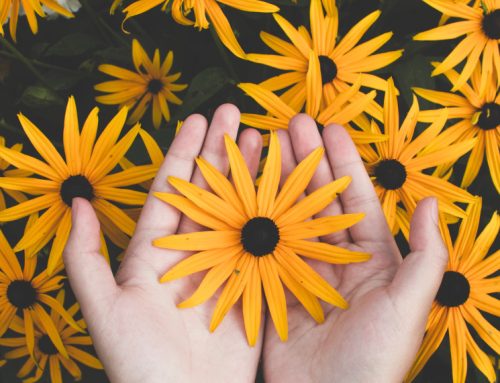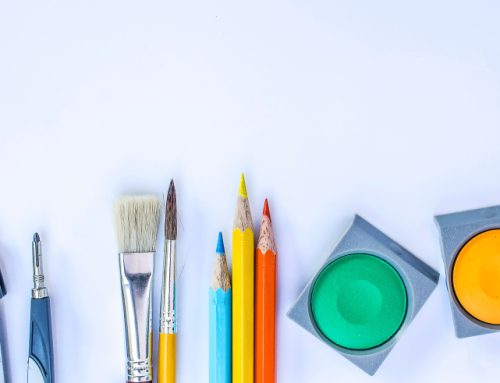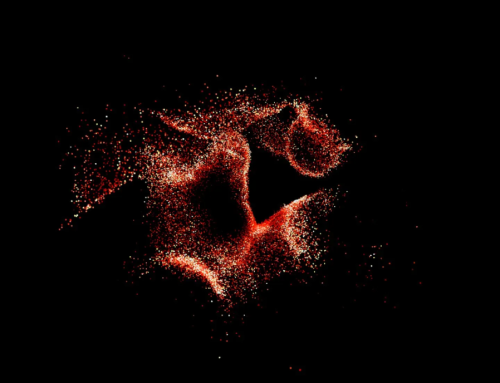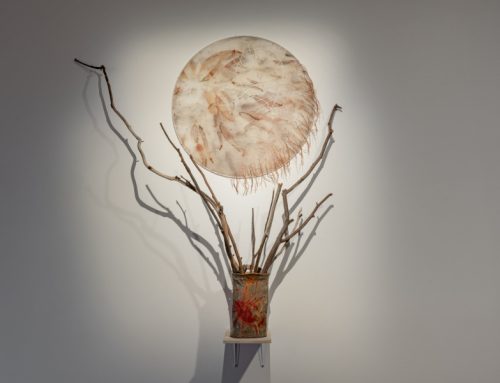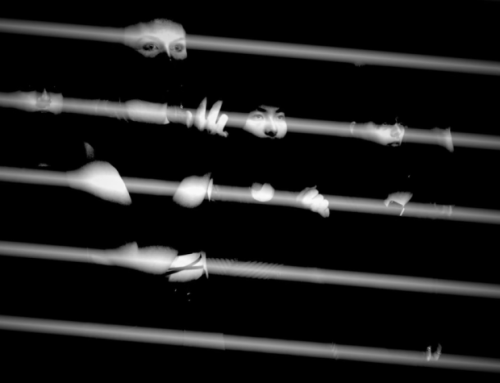Fibre artist Tracy Stirzaker describes her work as not only a personal exploration into her own emotional experiences, but also as a reflection of contemporary social and cultural influences. Her latest exhibition ‘Songs of Myself’ explores themes of self-esteem and listening to your inner knowing.
Can you describe your work and your process as an artist?
As a visual artist, I see myself as an observer and critic of contemporary Australian society. I love the tactile nature of fibres and employ painting and textiles techniques in my emotive fibre artworks. My artwork is personal and honest and intended to be thought provoking. I am inspired by my lived experience and explore embodied emotional experiences and socio-cultural factors through the repetition of words, motifs and symbols including the words ‘I AM ENOUGH’, the canary (your inner canary) and the flattened prescription medicine box (social constructs).
How does your process and work reflect on how you maintain your own physical and mental health?
I am a sensitive person and a seeker, I am always reading and researching and exploring the self – this feeds into my art practice and inspires new works. Both the research and the act of making allow me to express myself, to process the world around me and to reconnect with myself, this helps me maintain my mental health. My art making process is like an escape and the physical nature of making keeps me in the present moment. I use a lot of hand stitch in my work and the act of stitching is quite meditative. With the artwork I AM ENOUGH in orange, the repetitive stitching of I AM ENOUGH is quite affirming and empowering.
 What do you aim to awaken in others with your work?
What do you aim to awaken in others with your work?
I do believe that by sharing our stories we allow others to find solace and comfort in their own journeys and the idea that “I am not alone” – and my art practice allows me to do this. I hope to inspire conversations and to raise awareness on themes around the emotional body – including self-esteem and mental health. More recently my artworks, like ‘I am enough in orange’, are helping women to connect with their spirits and inspiring them to believe in themselves. Empowering them to listen to their inner canaries or inner knowing.
How have people reacted and responded to your work?
My solo show Recalibrate explored the concept of being overwhelmed in the everyday – the struggles between individuals, mental health and societal constructs. Some of the artworks were intentionally sensory overloading – people were confronted. One viewer cried and shared that she was struggling with her son and his mental health. Another thanked me for raising awareness about the struggles of mental health. People shared personal stories with me about mental health journeys from their own lives or their family members. The show did raise awareness about mental health in the everyday and really touched individuals, it was quite a privilege for me really.
What role do you think the arts can play in our cultural and societal well-being?
Cultural and socially, I believe people like to connect – with friends, family and the community. We want to be understood and accepted for who we are. I believe that the arts help to connect people and to raise awareness about topics that might be hard to talk about directly. The arts can touch on topics and share stories that make people feel like they are not alone and give hope. Both the viewing and making of art connect people – whether it’s a film, an artwork or a community art project. Art connects people in so many ways and it can help to break down barriers and stigmas.
What is the relationship between traditional crafts and art in your process?
I like the tactile nature of traditional crafts and I love to use everyday materials in my art practice, like fabrics from reclaimed clothing and household linen. Hand stitch embroidery, patchwork and applique techniques are traditionally women’s work and are an important part of our shared stories, for me it is a connection with traditions but also with the everyday. The reclaimed fabrics are embedded with stories of the people who wore them and their journeys – I feel this adds another layer to my artworks.
 In your latest exhibition, ‘Songs of Myself’ you explore themes of self-esteem and listening to your inner knowing. Why did you choose those themes and what did you discover in producing the works?
In your latest exhibition, ‘Songs of Myself’ you explore themes of self-esteem and listening to your inner knowing. Why did you choose those themes and what did you discover in producing the works?
I realised through my personal exploration that I was not alone in having self-doubt, and my art practice allowed me to lean into my inner canary to seek and affirm my place in the world. The ‘Songs of Myself’ solo exhibition was inspired by the work of English speaker and therapist Marisa Peer whose practice revolves around self-esteem, American researcher and storyteller Brene Brown, and Australia’s Sarah Wilson’s journey with anxiety in ‘First We Make the Beast Beautiful’. I wanted to share my journey and to inspire others to believe in themselves – to seek and listen to their inner canary. For me the art making and the show itself were both cathartic – it was healing to share my journey and my art, and to connect with others.
How did your audience respond to the exhibition?
The exhibition created conversations about people’s journeys and about self-esteem, and I loved sharing it with the viewers. Some of the viewers were quite moved by my show as it touched them deeply. As part of the ‘Songs of Myself’ exhibition I did an artist talk about my journey and art practice. A yogi friend hosted a restorative yoga session in the gallery and the participants took time to sit in the space and practice some self-care.
How do you think art can be used for healing and recovery in these current times of turmoil and change?
In a simple way art can lift your mood and allow you to press pause for a few moments. Art can make you laugh, and it can make you cry, it can transport you to another place. Art can raise awareness and allow us to share stories so that we know that we are in this together. Art creates connections and conversations and we need to feel connected. In times of turmoil the act of creating can bring comfort and allow you to be present – get you out of your head. For me I find it meditative to create and this does allow some healing and rest from the turmoils of life.
 Is there anything else you would like to share about your work, your process, and/or the role the arts can play in improving health outcomes?
Is there anything else you would like to share about your work, your process, and/or the role the arts can play in improving health outcomes?
Art is such a powerful tool, to engage in art as a practitioner for me is really rewarding. I have delved deep into my life and I express myself through my art – creating feels like home. Sharing my art with others creates connections and can empower people. With the ability to share stories, connect with people and touch the lives of the audience we can help people to look at their lives in context, to take a break from their troubles and make steps to improving their health.
For more information about the artist and her works follow this link:
http://www.tracystirzaker.com/

 What do you aim to awaken in others with your work?
What do you aim to awaken in others with your work? In your latest exhibition, ‘Songs of Myself’ you explore themes of self-esteem and listening to your inner knowing. Why did you choose those themes and what did you discover in producing the works?
In your latest exhibition, ‘Songs of Myself’ you explore themes of self-esteem and listening to your inner knowing. Why did you choose those themes and what did you discover in producing the works? Is there anything else you would like to share about your work, your process, and/or the role the arts can play in improving health outcomes?
Is there anything else you would like to share about your work, your process, and/or the role the arts can play in improving health outcomes?